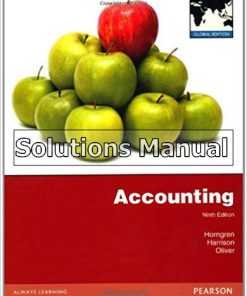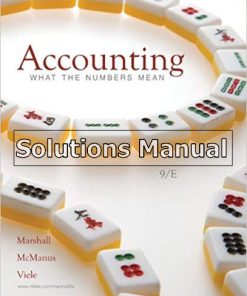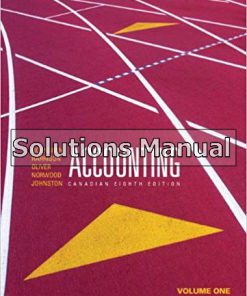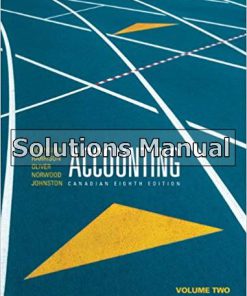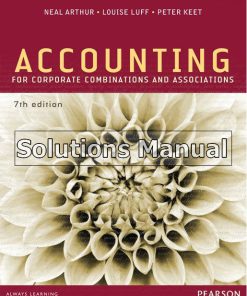Essential Foundations of Economics 7th Edition Bade Solutions Manual
$26.50$50.00 (-47%)
Essential Foundations of Economics 7th Edition Bade Solutions Manual.
You may also like
Essential Foundations of Economics 7th Edition Bade Solutions Manual

Product details:
- ISBN-10 : 0133462544
- ISBN-13 : 978-0133462548
- Author: Robin Bade; Michael Parkin
—
For one-semester Principles of Economics courses at two- and four-year colleges and universities
A practice-oriented learning system that breaks the traditional textbook mold
To help students focus on the most important concepts–and effectively practice application of those concepts–Essential Foundations of Economics is structured around a Checklist/Checkpoint system. The result is a patient, confidence-building program that prepares students to use economics in their everyday lives, regardless of what their future career will be.
Table contents:
- Part 1 Introduction
- Chapter 1 Getting Started
- Chapter Checklist
- 1.1 Definition and Questions
- Scarcity
- Economics Defined
- What, How, and For Whom?
- Can the Pursuit of Self-Interest Be in the Social Interest?
- Checkpoint 1.1
- 1.2 The Economic Way of Thinking
- Economic Ideas
- A Choice Is a Tradeoff
- Cost: What You Must Give Up
- Benefit: What You Gain
- Rational Choice
- How Much? Choosing at the Margin
- Choices Respond to Incentives
- Economics as Social Science
- Economics as Policy Tool
- Checkpoint 1.2
- Chapter summary
- Chapter Checkpoint
- Appendix: Making and Using Graphs
- Basic Idea
- Interpreting Data Graphs
- Interpreting Graphs Used in Economic Models
- The Slope of a Relationship
- Relationships Among More Than Two Variables
- Appendix Checkpoint
- Eye on the Past Adam Smith and the Birth of Economics as a Social Science
- Eye on the Benefit and cost of school Did You Make the Right Decision?
- Chapter 2 The U.S. and Global Economies
- Chapter Checklist
- 2.1 What, How, and For Whom?
- What Do We Produce?
- How Do We Produce?
- For Whom Do We Produce?
- Checkpoint 2.1
- 2.2 The Global Economy
- The People
- The Economies
- What in the Global Economy?
- How in the Global Economy?
- For Whom in the Global Economy?
- Checkpoint 2.2
- 2.3 The Circular Flows
- Households and Firms
- Markets
- Real Flows and Money Flows
- Governments
- Governments in the Circular Flow
- Circular Flows in the Global Economy
- Checkpoint 2.3
- Chapter summary
- Chapter Checkpoint
- EYE on the U.S. Economy What We Produce
- EYE on the PAST Changes in What We Produce
- EYE on the U.S. ECONOMY Changes in How We Produce in the Information Economy
- EYE on the Dreamliner Who Makes the Dreamliner?
- EYE on the GLOBAL ECONOMY Differences in How We Produce
- EYE on YOUR LIFE The U.S. and Global Economies in Your Life
- EYE on the PAST Growing Government
- EYE on the GLOBAL ECONOMY The Ups and Downs in International Trade
- Chapter 3 The Economic Problem
- Chapter Checklist
- 3.1 Production Possibilities
- Production Possibilities Frontier
- Checkpoint 3.1
- 3.2 Opportunity Cost
- The Opportunity Cost of a Cell Phone
- Opportunity Cost and the Slope of the PPF
- Opportunity Cost Is a Ratio
- Increasing Opportunity Costs Are Everywhere
- Your Increasing Opportunity Cost
- Checkpoint 3.2
- 3.3 Economic Growth
- Checkpoint 3.3
- 3.4 Specialization and Trade
- Absolute Advantage and Comparative Advantage
- Comparative Advantage: An Example
- Achieving Gains from Trade
- Checkpoint 3.4
- Chapter summary
- Chapter Checkpoint
- EYE on YOUR LIFE Your Production Possibilities Frontier
- EYE on the ENVIRONMENT Is Wind Power Free?
- EYE on the U.S. ECONOMY Expanding Our Production Possibilities
- EYE on the GLOBAL ECONOMY Hong Kong’s Rapid Economic Growth
- EYE on the U.S. ECONOMY No One Knows How to Make a Pencil
- EYE on YOUR LIFE Your Comparative Advantage
- Chapter 4 Demand and Supply
- Chapter Checklist
- Competitive Markets
- 4.1 Demand
- The Law of Demand
- Demand Schedule and Demand Curve
- Individual Demand and Market Demand
- Changes in Demand
- Change in Quantity Demanded Versus Change in Demand
- Checkpoint 4.1
- 4.2 Supply
- The Law of Supply
- Supply Schedule and Supply Curve
- Individual Supply and Market Supply
- Changes in Supply
- Change in Quantity Supplied Versus Change in Supply
- Checkpoint 4.2
- 4.3 Market Equilibrium
- Price: A Market’s Automatic Regulator
- Predicting Price Changes: Three Questions
- Effects of Changes in Demand
- Effects of Changes in Supply
- Effects of Changes in Both Demand and Supply
- Checkpoint 4.3
- Chapter summary
- Chapter Checkpoint
- EYE on YOUR LIFE Understanding and Using Demand and Supply
- EYE on Tuition Why Does Tuition Keep Rising?
- EYE on the GLOBAL ECONOMY The Market for Solar Panels
- Part 2 A Closer Look at Markets
- Chapter 5 Elasticities of Demand and Supply
- Chapter Checklist
- 5.1 The Price Elasticity of Demand
- Percentage Change in Price
- Percentage Change in Quantity Demanded
- Comparing the Percentage Changes in Price and Quantity
- Elastic and Inelastic Demand
- Influences on the Price Elasticity of Demand
- Computing the Price Elasticity of Demand
- Interpreting the Price Elasticity of Demand Number
- Elasticity Along a Linear Demand Curve
- Total Revenue and the Price Elasticity of Demand
- Applications of the Price Elasticity of Demand
- Checkpoint 5.1
- 5.2 The Price Elasticity of Supply
- Elastic and Inelastic Supply
- Influences on the Price Elasticity of Supply
- Computing the Price Elasticity of Supply
- Checkpoint 5.2
- 5.3 Cross Elasticity and Income Elasticity
- Cross Elasticity of Demand
- Income Elasticity of Demand
- Checkpoint 5.3
- Chapter summary
- Chapter Checkpoint
- EYE on the GLOBAL ECONOMY Price Elasticities of Demand
- EYE on the Price of Gasoline What Do You Do When the Price of Gasoline Rises?
- EYE on YOUR LIFE Your Price Elasticities of Demand
- Chapter 6 Efficiency and Fairness of Markets
- Chapter Checklist
- 6.1 Allocation Methods and efficiency
- Resource Allocation Methods
- Using Resources Efficiently
- Checkpoint 6.1
- 6.2 Value, Price, and Consumer Surplus
- Demand and Marginal Benefit
- Consumer Surplus
- Checkpoint 6.2
- 6.3 Cost, Price, and Producer Surplus
- Supply and Marginal Cost
- Producer Surplus
- Checkpoint 6.3
- 6.4 Are Markets Efficient?
- Marginal Benefit Equals Marginal Cost
- Total Surplus Is Maximized
- The Invisible Hand
- Market Failure
- Sources of Market Failure
- Alternatives to the Market
- Checkpoint 6.4
- 6.5 Are Markets Fair?
- It’s Not Fair If the Rules Aren’t Fair
- It’s Not Fair If the Result Isn’t Fair
- Compromise
- Checkpoint 6.5
- Chapter summary
- Chapter Checkpoint
- EYE on the U.S. ECONOMY The Invisible Hand and e-Commerce
- EYE on Price Gouging Should Price Gouging Be Illegal?
- EYE on YOUR LIFE Allocation Methods, Efficiency, and Fairness
- Chapter 7 Government Actions in Markets
- Chapter Checklist
- 7.1 Taxes on Buyers and Sellers
- Tax Incidence
- Taxes and Efficiency
- Incidence, Inefficiency, and Elasticity
- Incidence, Inefficiency, and the Elasticity of Demand
- Incidence, Inefficiency, and the Elasticity of Supply
- Checkpoint 7.1
- 7.2 Price Ceilings
- A Rent Ceiling
- Are Rent Ceilings Efficient?
- Are Rent Ceilings Fair?
- If Rent Ceilings Are So Bad, Why Do We Have Them?
- Checkpoint 7.2
- 7.3 Price Floors
- The Minimum Wage
- Is the Minimum Wage Efficient?
- Is the Minimum Wage Fair?
- If the Minimum Wage Is So Bad, Why Do We Have It?
- Checkpoint 7.3
- 7.4 Price Supports in Agriculture
- How Governments Intervene in Markets for Farm Products
- Price Support: An Illustration
- Checkpoint 7.4
- Chapter summary
- Chapter Checkpoint
- EYE on the U.S. ECONOMY The Federal Minimum Wage
- EYE on Price Regulation Can the President Repeal the Laws of Supply and Demand?
- EYE on YOUR LIFE Price Ceilings and Price Floors
- Chapter 8 Global Markets in Action
- Chapter Checklist
- 8.1 How Global Markets Work
- International Trade Today
- What Drives International Trade?
- Why the United States Imports T-Shirts
- Why the United States Exports Airplanes
- Checkpoint 8.1
- 8.2 Winners, Losers, and Net Gains From Trade
- Gains and Losses from Imports
- Gains and Losses from Exports
- Checkpoint 8.2
- 8.3 International Trade Restrictions
- Tariffs
- Import Quotas
- Other Import Barriers
- Export Subsidies
- Checkpoint 8.3
- 8.4 The Case Against Protection
- Three Traditional Arguments for Protection
- Four Newer Arguments for Protection
- Why Is International Trade Restricted?
- Checkpoint 8.4
- Chapter summary
- Chapter Checkpoint
- EYE on the U.S. ECONOMY U.S. Exports and Imports
- EYE on Globalization Who Wins and Who Loses from Globalization?
- EYE on the PAST The History of U.S. Tariffs
- EYE on YOUR LIFE International Trade
- Chapter 9 Externalities: Pollution, Education,and Health Care
- Chapter Checklist
- Externalities in Our Daily Lives
- Negative Production Externalities
- Positive Production Externalities
- Negative Consumption Externalities
- Positive Consumption Externalities
- 9.1 Negative Externalities: Pollution
- Private Costs and Social Costs
- Production and Pollution: How Much?
- Establish Property Rights
- Mandate Clean Technology
- Tax or Cap and Price Pollution
- Checkpoint 9.1
- 9.2 Positive Externalities: Education and Health Care
- Private Benefits and Social Benefits
- Government Actions in the Face of External Benefits
- Economic Problems in Health-Care Markets
- Health-Care Systems in Other Countries
- A Reform Idea
- Checkpoint 9.2
- Chapter summary
- Chapter Checkpoint
- EYE on the U.S. ECONOMY U.S. Air Pollution Trends
- EYE on Climate Change How Can We Limit Climate Change?
- EYE on the U.S. ECONOMY Education Quality: Charter Schools and Vouchers
- EYE on YOUR LIFE Externalities in Your Life
- EYE on the U.S. ECONOMY Health Care in the United States: A Snapshot
- Part 3 Prices, Profits, and Industry Performance
- Chapter 10 Production and Cost
- Chapter Checklist
- 10.1 Economic Cost and Profit
- The Firm’s Goal
- Accounting Cost and Profit
- Opportunity Cost
- Economic Profit
- Checkpoint 10.1
- Short Run and Long Run
- 10.2 Short-Run Production
- Total Product
- Marginal Product
- Average Product
- Checkpoint 10.2
- 10.3 Short-Run Cost
- Total Cost
- Marginal Cost
- Average Cost
- Why the Average Total Cost Curve Is U-Shaped
- Cost Curves and Product Curves
- Shifts in the Cost Curves
- Checkpoint 10.3
- 10.4 Long-Run Cost
- Plant Size and Cost
- The Long-Run Average Cost Curve
- Checkpoint 10.4
- Chapter summary
- Chapter Checkpoint
- EYE on YOUR LIFE Your Average and Marginal Grades
- EYE on Retailers’ Costs Which Store Has the Lower Costs: Wal-Martor 7-Eleven?
- Chapter 11 Perfect Competition
- Chapter Checklist
- Market Types
- Perfect Competition
- Other Market Types
- 11.1 A Firm’s Profit-Maximizing Choices
- Price Taker
- Revenue Concepts
- Profit-Maximizing Output
- Marginal Analysis and the Supply Decision
- Temporary Shutdown Decision
- The Firm’s Short-Run Supply Curve
- Checkpoint 11.1
- 11.2 Output, Price, and Profit in the Short Run
- Market Supply in the Short Run
- Short-Run Equilibrium in Normal Times
- Short-Run Equilibrium in Good Times
- Short-Run Equilibrium in Bad Times
- Checkpoint 11.2
- 11.3 Output, Price, and Profit in the Long Run
- Entry and Exit
- The Effects of Exit
- Change in Demand
- Technological Change
- Is Perfect Competition Efficient?
- Is Perfect Competition Fair?
- Checkpoint 11.3
- Chapter summary
- Chapter Checkpoint
- EYE on Record Stores Where Have All the Record Stores Gone?
- EYE on YOUR LIFE The Perfect Competition that You Encounter
- Chapter 12 Monopoly
- Chapter Checklist
- 12.1 Monopoly and How it Arises
- How Monopoly Arises
- Monopoly Price-Setting Strategies
- Checkpoint 12.1
- 12.2 Single-Price Monopoly
- Price and Marginal Revenue
- Marginal Revenue and Elasticity
- Output and Price Decision
- Checkpoint 12.2
- 12.3 Monopoly and Competition Compared
- Output and Price
- Is Monopoly Efficient?
- Is Monopoly Fair?
- Rent Seeking
- Checkpoint 12.3
- 12.4 Price Discrimination
- Price Discrimination and Consumer Surplus
- Profiting by Price Discriminating
- Perfect Price Discrimination
- Price Discrimination and Efficiency
- Checkpoint 12.4
- 12.5 Monopoly Regulation
- Efficient Regulation of a Natural Monopoly
- Second-Best Regulation of a Natural Monopoly
- Checkpoint 12.5
- Chapter summary
- Chapter Checkpoint
- EYE on the U.S. ECONOMY Airline Price Discrimination
- EYE on Microsoft Are Microsoft’s Prices Too High?
- EYE on YOUR LIFE Monopoly in Your Everyday Life
- Chapter 13 Monopolistic Competition and Oligopoly
- Chapter Checklist
- 13.1 What is Monopolistic Competition?
- Large Number of Firms
- Product Differentiation
- Competing on Quality, Price, and Marketing
- Entry and Exit
- Identifying Monopolistic Competition
- Output and Price in Monopolistic Competition
- The Firm’s Profit-Maximizing Decision
- Long Run: Zero Economic Profit
- Monopolistic Competition and Perfect Competition
- Checkpoint 13.1
- 13.2 Product Development and Marketing
- Innovation and Product Development
- Marketing
- Checkpoint 13.2
- 13.3 Oligopoly
- Collusion
- Duopoly in Airplanes
- The Duopolists’ Dilemma
- Checkpoint 13.3
- 13.4 Game Theory
- What Is a Game?
- The Prisoners’ Dilemma
- The Duopolists’ Dilemma
- Advertising and Research Games in Oligopoly
- Repeated Games
- Is Oligopoly Efficient?
- Checkpoint 13.4
- Chapter summary
- Chapter Checkpoint
- EYE on the U.S. ECONOMY Examples of Monopolistic Competition
- EYE on cell phones Which Cell Phone?
- EYE on YOUR LIFE Some Selling Costs You Pay
- EYE on YOUR LIFE A Game You Might Play
- EYE on the cell-phone OLIGOPOLY Is Two Too Few?
- Part 4 Monitoring the Macroeconomy
- Chapter 14 GDP: A Measure of Total Production and Income
- Chapter Checklist
- 14.1 GDP, Income, and Expenditure
- GDP Defined
- Circular Flows in the U.S. Economy
- Expenditure Equals Income
- Checkpoint 14.1
- 14.2 Measuring U.S. GDP
- The Expenditure Approach
- The Income Approach
- GDP and Related Measures of Production and Income
- Real GDP and Nominal GDP
- Calculating Real GDP
- Using the Real GDP Numbers
- Checkpoint 14.2
- 14.3 The Uses and Limitations of Real GDP
- The Standard of Living Over Time
- Tracking the Course of the Business Cycle
- The Standard of Living Among Countries
- Goods and Services Omitted from GDP
- Other Influences on the Standard of Living
- Checkpoint 14.3
- Chapter summary
- Chapter Checkpoint
- Appendix: Measuring Real GDP
- The Problem With Base-Year Prices
- Value Production in the Prices of Adjacent Years
- Appendix Checkpoint
- EYE on the U.S. ECONOMY Is a Computer Program an Intermediate Good or a Final Good?
- EYE on the Booms and Busts How Do We Track the Booms and Busts of our Economy?
- EYE on YOUR LIFE Making GDP Personal
- EYE on the GLOBAL ECONOMY Which Country Has the Highest Standard of Living?
- Chapter 15 Jobs and Unemployment
- Chapter Checklist
- 15.1 Labor Market Indicators
- Current Population Survey
- Population Survey Criteria
- Two Main Labor Market Indicators
- Alternative Measures of Unemployment
- Checkpoint 15.1
- 15.2 Labor Market Trends and Fluctuations
- Unemployment Rate
- The Participation Rate
- Alternative Measures of Unemployment
- A Closer Look at Part-Time Employment
- Checkpoint 15.2
- 15.3 Unemployment and Full Employment
- Frictional Unemployment
- Structural Unemployment
- Cyclical Unemployment
- “Natural” Unemployment
- Unemployment and Real GDP
- Checkpoint 15.3
- Chapter summary
- Chapter Checkpoint
- EYE on the U.S. ECONOMY The Current Population Survey
- EYE on the GLOBAL ECONOMY Unemployment Around the World
- EYE on the GLOBAL ECONOMY Women in the Labor Force
- EYE on the Unemployed How Long Does it Take to Find a Job?
- EYE on YOUR LIFE Your Labor Market Status and Activity
- Chapter 16 The CPI and the Cost of Living
- Chapter Checklist
- 16.1 The Consumer Price Index
- Reading the CPI Numbers
- Constructing the CPI
- The CPI Market Basket
- The Monthly Price Survey
- Calculating the CPI
- Measuring Inflation and Deflation
- Checkpoint 16.1
- 16.2 The CPI and Other Price Level Measures
- Sources of Bias in the CPI
- The Magnitude of the Bias
- Two Consequences of the CPI Bias
- Alternative Measures of the Price Level and Inflation Rate
- Checkpoint 16.2
- 16.3 Nominal and Real Values
- Dollars and Cents at Different Dates
- Nominal and Real Values in Macroeconomics
- Nominal GDP and Real GDP
- Nominal Wage Rate and Real Wage Rate
- Nominal Interest Rate and Real Interest Rate
- Checkpoint 16.3
- Chapter summary
- Chapter Checkpoint
- EYE on the PAST 700 Years of Inflation and Deflation
- EYE on the U.S. ECONOMY Deflating the GDP Balloon
- EYE on the PAST The Nominal and Real Wage Rates of Presidents of the United States
- EYE on Box Ofice Hits Which Movie Really Was the Biggest Box Office Hit?
- EYE on YOUR LIFE A Student’s CPI
- Part 5 Understanding The Macroeconomy
- Chapter 17 Potential GDP and Economic Growth
- Chapter Checklist
- Macroeconomic Approaches and Pathways
- The Three Main Schools of Thought
- Today’s Consensus
- The Road Ahead
- 17.1 Potential GDP
- The Production Function
- The Labor Market
- Checkpoint 17.1
- 17.2 The Basics of Economic Growth
- Calculating Growth Rates
- The Magic of Sustained Growth
- Checkpoint 17.2
- 17.3 Labor Productivity Growth
- Labor Productivity
- Saving and Investment in Physical Capital
- Expansion of Human Capital and Discovery of New Technologies
- Combined Influences Bring Labor Productivity Growth
- What Keeps Labor Productivity Growing?
- Checkpoint 17.3
- 17.4 Achieving Faster Growth
- Preconditions for Economic Growth
- Policies to Achieve Faster Growth
- How Much Difference Can Policy Make?
- Checkpoint 17.4
- Chapter summary
- Chapter Checkpoint
- EYE on the U.S. ECONOMY The Lucas Wedge and the Okun Gap
- EYE on the GLOBAL ECONOMY Potential GDP in the United States and European Union
- EYE on the U.S. ECONOMY Why Do Americans Earn More and Produce More Than Europeans?
- EYE on the PAST How Fast Has Real GDP per Person Grown?
- EYE on the U.S. ECONOMY U.S. Labor Productivity Growth Since 1960
- EYE on YOUR LIFE How You Influence and Are Influenced by Economic Growth
- EYE on Rich and Poor Nations Why Are Some Nations Rich and Others Poor?
- Chapter 18 Money and the Monetary System
- Chapter Checklist
- 18.1 What is Money?
- Definition of Money
- The Functions of Money
- Money Today
- Official Measures of Money: M1 and M2
- Checks, Credit Cards, Debit Cards, and E-Checks
- An Embryonic New Money: E-Cash
- Checkpoint 18.1
- 18.2 The Banking System
- Commercial Banks
- Thrift Institutions,
- Money Market Funds
- Checkpoint 18.2
- 18.3 The Federal Reserve System
- The Structure of the Federal Reserve
- The Fed’s Policy Tools
- How the Fed’s Policy Tools Work
- Checkpoint 18.3
- 18.4 Regulating the Quantity of Money
- Creating Deposits by Making Loans
- How Open Market Operations Change the Monetary Base
- The Multiplier Effect of an Open Market Operation
- The Money Multiplier
- Checkpoint 18.4
- Chapter summary
- Chapter Checkpoint
- EYE on the PAST The “Invention” of Banking
- EYE on the U.S. ECONOMY Commercial Banks Under Stress in the Financial Crisis
- EYE on YOUR LIFE Money and Your Role in Its Creation
- EYE on Creating Money How Does the Fed Create Money and Regulate Its Quantity?
- Chapter 19 Aggregate Supply and Aggregate Demand
- Chapter Checklist
- 19.1 Aggregate Supply
- Aggregate Supply Basics
- Changes in Aggregate Supply
- Checkpoint 19.1
- 19.2 Aggregate Demand
- Aggregate Demand Basics
- Changes in Aggregate Demand
- The Aggregate Demand Multiplier
- Checkpoint 19.2
- 19.3 Explaining Economic Trends and Fluctuations
- Macroeconomic Equilibrium
- Three Types of Macroeconomic Equilibrium
- Economic Growth and Inflation Trends
- The Business Cycle
- Inflation Cycles
- Deflation and the Great Depression
- Checkpoint 19.3
- Chapter summary
- Chapter Checkpoint
- EYE on the U.S. ECONOMY U.S. Economic Growth, Inflation, and the Business Cycle
- EYE on YOUR LIFE Using the AS-AD Model
- EYE on the Business Cycle Why Did the U.S. Economy Go into Recession in 2008?
- Chapter 20 Fiscal Policy and Monetary Policy
- Chapter Checklist
- 20.1 The Federal Budget and Fiscal Policy
- The Federal Budget
- Budget Balance and Debt
- Discretionary Fiscal Policy: Demand-Side Effects
- A Successful Fiscal Stimulus
- Discretionary Fiscal Policy: Supply-Side Effects
- Limitations of Discretionary Fiscal Policy
- Automatic Fiscal Policy
- Cyclical and Structural Budget Balances
- Schools of Thought and Cracks in Today’s Consensus
- Checkpoint 20.1
- 20.2 The Federal Reserve and Monetary Policy
- The Monetary Policy Process
- The Federal Funds Rate Target
- The Ripple Effects of the Fed’s Actions
- Monetary Stabilization in the AS-AD Model
- Limitations of Monetary Stabilization Policy
- Checkpoint 20.2
- Chapter summary
- Chapter Checkpoint
- EYE on the PAST Federal Tax Revenues, Outlays, Deficits, and Debt
- EYE on the U.S. ECONOMY A Social Security and Medicare Time Bomb
- EYE on the U.S. ECONOMY The U.S. Structural and Cyclical Budget Balances
- Eye on Fiscal Stimulus Can Fiscal Stimulus End a Recession?
- Eye on the Fed In A Crisis Did the Fed Save Us From Another Great Depression?
- Eye on Your Life Fiscal and Monetary Policy and How They Affect You
- Glossary
- Index
- Credits
People also search:
essential foundations of economics 7th edition pdf
what are the five foundations of economics
which items are among the five foundations of economics
7 importance of economics
essentials of economics 7th edition







